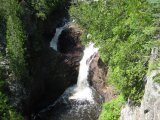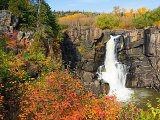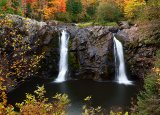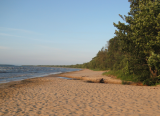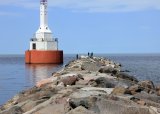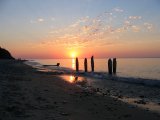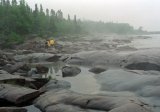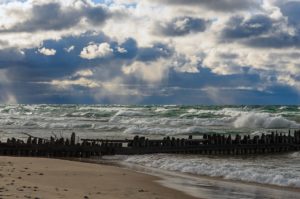
Lake Superior is the largest of the Great Lakes of North America; It is also the world’s largest freshwater lake by surface area, and the third largest freshwater lake by volume. A little known fact is that Lake Superior contains almost 10% of the Earth’s freshwater and that Lake Superior contains more water than all the other Great Lakes combined .
The lake is shared by the Canadian province of Ontario to the north, the U.S. state of Minnesota to the west, and Wisconsin and the Upper Peninsula of Michigan to the south. The farthest north and west of the Great Lakes chain, Superior has the highest elevation of all five great lakes and drains into the St. Mary’s River.
Lake Superior has a surface area of 31,700 square miles which is about the same size of the State of South Carolina or the country of Austria. It has a length of 350 miles and maximum width of 160 miles. Its average depth is 483 ft and it’s maximum depth is 1,333 ft.There is enough water in Lake Superior to cover the entire land mass of North and South America to a depth of 12″. Lake Superior has more than 2,726 miles of coastline.
Lake Superior empties into Lake Huron via the St. Marys River and the Soo Locks. Lake Superior is the largest freshwater lake in the world in area (if Lakes Michigan and Huron are taken separately; see Lake Michigan–Huron), and the third largest in volume, behind Lake Baikal in Siberia and Lake Tanganyika in East Africa. The Caspian Sea, while larger than Lake Superior in both surface area and volume, is brackish; though presently isolated, prehistorically the Caspian has been repeatedly connected to and then isolated from the Mediterranean via the Black Sea.
Over 200 rivers and more than 100 streams are the source of Lake Superiors water. The largest include the Nipigon River, the St. Louis River, the Pigeon River, the Pic River, the White River, the Michipicoten River, the Bois Brule River and the Kaministiquia River. Lake Superior drains into Lake Huron via the St. Marys River. The Soo Locks were built to enable ships to bypass the water rapids and to overcome the 25-foot (8 m) height difference between Lakes Superior and Huron.
The largest island in Lake Superior is Isle Royale which is part of the state of Michigan. Isle Royale contains several lakes wthin itself, some of which also contain other islands. Other popular islands include Madeline Island which is a part of the state of Wisconsin, Michipicoten Island which lies in the provincial waters of Ontario, and Grand Island, which is famous for the Grand Island National Recreation Area, which also is part of the state of Michigan.
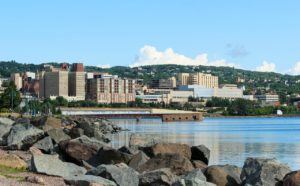
The larger cities on Lake Superior include the twin ports of Duluth, Minnesota and Superior, Wisconsin; Thunder Bay, Ontario; Marquette, Michigan; and the twin cities of Sault Ste. Marie, Michigan, and Sault Ste. Marie, Ontario. Duluth-Superior, at the western end of Lake Superior, is the most inland point on the St. Lawrence Seaway and the most inland port in the world.
Among the scenic places on the lake are Apostle Islands National Lakeshore, Isle Royale National Park, Porcupine Mountains Wilderness State Park, Pukaskwa National Park, Lake Superior Provincial Park, Grand Island National Recreation Area, Sleeping Giant (Ontario) and Pictured Rocks National Lakeshore.
The southern shore of Lake Superior between Grand Marais, Michigan, and Whitefish Point is known as the “Graveyard of the Great Lakes” and more ships have been lost around the Whitefish Point area than any other part of Lake Superior. These shipwrecks are now protected by the Whitefish Point Underwater Preserve from looters and souvenir hunters.
Fishing:
Lake Superior’s cold, clear water is ideal for native ciscoes and lake trout. Lake Superior supports 52 fish species, fewer than any other Great Lake, in part because other lakes offer more diverse temperatures and habitats.
Unlike other lakes, Lake Superior’s native species retain the upper hand over invasive and introduced species. Ciscoes and their relatives provide an important link between zooplankton and predatory fish. The only abundant invasive plankton-eating fish is the rainbow smelt.
Lean lake trout are the backbone of recreational fisheries in offshore waters of Lake Superior. Bold anglers can find huge lake trout near sunken islands and rock reefs. Stannard Rock north of Marquette, Michigan, is one such destination that has produced fish weighing over 60 pounds. While trolling is typically the preferred method of lake trout fishing in the Great Lakes, Lake Superior also offers good opportunities for jigging.
Harbor areas and protected bays like Duluth Harbor and Tahquamenon Bay offer some opportunities for coolwater fish like pike, walleye, and perch. Introduced coho salmon and steelhead also provide fisheries near river mouths. Although these species were originally stocked, natural reproduction in Lake Superior rivers is now high enough to sustain populations.
Lake Superior’s commercial fisheries target lake whitefish, lake trout, and ciscoes. The largest market for cisco (also called lake herring) is for roe (eggs) exported to Scandinavian countries. Cisco and bloater are also sold as “smoked chubs” at many roadside fish markets around Lake Superior.
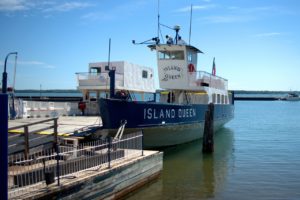
Things to do at Isle Royale:
Surrounded by Lake Superior, Isle Royale offers unparalleled solitude and adventures for backpackers, hikers, boaters, kayakers, canoeists and scuba divers. Visiting Isle Royale can be arranged by ship/ferry. The Ranger III, one of the passenger ships, is a 165 foot long, 34 feet wide, 648 ton vessel that carries 128 passengers. An experienced nine-member crew takes great pride in maintaining the vessel and serving its passengers. All service departs from Houghton, Michigan or Rock Harbor on Isle Royale.
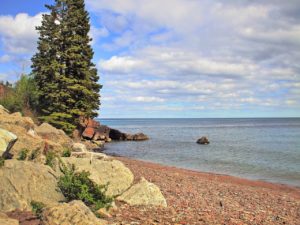
Isle Royale has 36 campgrounds located across the island. Campsites are accessible only by foot or watercraft. All campgrounds offer tent sites, a water source, and outhouses. Some campgrounds on Lake Superior offer shelters and picnic tables. For boaters and parties of 6 or fewer, overnight permits are free. The park charges a $7 per person daily entrance fee to enter or remain within the park per calendar day. This includes the day you arrive and the day you depart the park. If you have a valid Federal Recreation Pass (Annual, Military, Senior, Access, or Volunteer) entrance fees are waived. No further payment is necessary though you are required to bring the pass with you to the island.
- Backpackers hike from one campground to another, usually traveling six to eight miles per day.
- There are several campgrounds on the Lake Superior shoreline which have docks for power boaters and sail boaters.
- Canoes and kayak campgrounds, located inland, are only accessible by non-motorized boats.
- cross-country camping is also allowed with an additional permit addendum.
List of National Parks At Lake Superior:
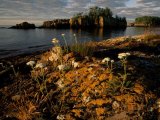 Isle Royale National Park (894 square miles)
Isle Royale National Park (894 square miles)
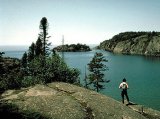 Pukaskwa National Park, Heron Bay, Ontario (725 square miles)
Pukaskwa National Park, Heron Bay, Ontario (725 square miles)
National Lakeshore
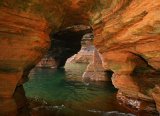 Apostle Islands National Lakeshore, Bayfield, Wisconsin (108 square miles)
Apostle Islands National Lakeshore, Bayfield, Wisconsin (108 square miles)
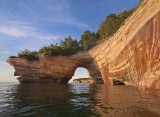 Pictured Rocks National Lakeshore, Munising, Michigan
Pictured Rocks National Lakeshore, Munising, Michigan
National Monuments
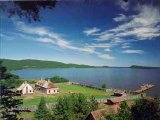 Grand Portage National Monument, Grand Portage, Minnesota
Grand Portage National Monument, Grand Portage, Minnesota
National Historical Parks
Minnesota:
 Gooseberry Falls State Park (most visited state park)
Gooseberry Falls State Park (most visited state park)
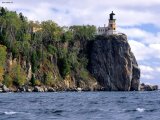 Split Rock Lighthouse State Park
Split Rock Lighthouse State Park
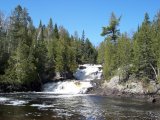 George H. Crosby Manitou State Park
George H. Crosby Manitou State Park
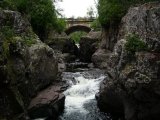 Temperance River State Park, Schroeder
Temperance River State Park, Schroeder
Wisconsin:
Copper Falls State Park, Mellon
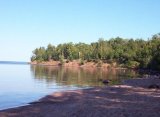 Big Bay State Park, Madeline Island
Big Bay State Park, Madeline Island
Michigan:
 Porcupine Mountains Wilderness State Park, Ontonagon
Porcupine Mountains Wilderness State Park, Ontonagon
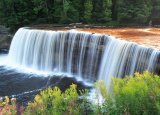 Tahquamenon Falls State Park, Paradise
Tahquamenon Falls State Park, Paradise
Ontario Provincial Parks:
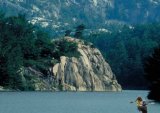 Michipicoten Island Provincial Park, Ontario (141 square miles)
Michipicoten Island Provincial Park, Ontario (141 square miles)
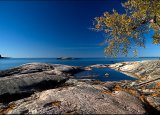 Lake Superior Provincial Park, Wawa, Ontario
Lake Superior Provincial Park, Wawa, Ontario
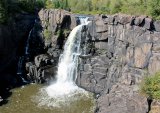 Pigeon River Provincial Park, Ontario
Pigeon River Provincial Park, Ontario
Kakabeka Falls Provincial Park, Ontario
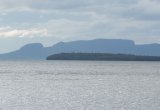 Sleeping Giant Provincial Park, Ontario
Sleeping Giant Provincial Park, Ontario
 Ruby Lake Provincial Park, Ontario
Ruby Lake Provincial Park, Ontario
 Rainbow Falls Provincial Park, Rossport, Ontario
Rainbow Falls Provincial Park, Rossport, Ontario
Fast Facts about Lake Superior:
- The largest by volume
- In the summer, the sun sets more than 35 minutes later on the western shore of Lake Superior than at its southeastern edge.
- Lake Superior has over 400 islands, the largest of which is Isle Royale, with a size of 207 square miles.
- The deepest and coldest
- Retention time = 191 years (a measure based on the volume of water in the lake and the mean rate of outflow)
- Most of the Superior basin is forested, with little agriculture because of a cool climate and poor soils.
- Sparse population
- Relatively few pollutants enter Lake Superior, except through airborne transport
- The shoreline and islands that rim the lake stretch 2,726 miles



